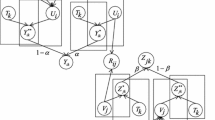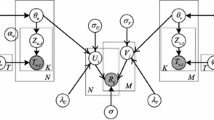Abstract
In order to effectively solve the problem of new items and obviously improve the accuracy of the recommended results, we proposed a collaborative recommendation algorithm based on improved probabilistic latent semantic model in this paper, which introduces popularity factor into probabilistic latent semantic analysis to derive probabilistic matrix factorization model. The core idea is to integrate the semantic knowledge into the recommendation process to overcome the shortcomings of the traditional recommendation algorithm. We introduced popularity factor to form a quintuple vector so as to understand user preference, and can integrate the probabilistic matrix factorization to solve the problem of data sparsity on basis of Probabilistic Latent Semantic Analysis; then the probabilistic matrix factorization model is adopted to construct the weighted similarity function to compute the recommendation result. Experimental study on real-world data-sets demonstrates that our proposed method can outperform three state-of-the art methods in recommendation accuracy.



Similar content being viewed by others
References
Kim H-N, Ji A-T, Ha I et al (2010) Collaborative filtering based on collaborative tagging for enhancing the quality of recommendation[J]. Electron Commer Res Appl 9(1):73–83
Lee J-S, Olafsson S (2009) Two-way cooperative prediction for collaborative filtering recommendations [J]. Expert Syst Appl 36(3):5353–5361
Wang KB, Tan Y (2011) A new collaborative filtering recommendation approach based on naive Bayesian method[C]//proceedings of theSecond international conference on advances in swarm intelligence. Springer, Berlin, pp 218–227
Ferrara F, Tasso C (2012) Integrating semantic; relatedness in a collaborative filtering system . Proc of Mensch&Computer Workshophand[C]. IEEE, Shanghai, pp 75–82
Cantador I, Castells P, Bellogin A (2016) An enhanced semanticlayer for hybrid recommender systems[J]. Int J Semantic Weh Info Syst 7(1):44–78
Shambour Q, Lu J (2011) A hybrid multi-criteria semantic-enhanced collaborative filtering approach for personalized recommendations. Proc of IEEE /WIC/ACM international conference on web intelligence and intelligent agent technology[C]. IEEE, Warsaw, pp 71–78
Woolley AW, Chabris CF, Pentland A (2015) Evidence for a collective intelligence factor in the performance ofhuman groups [J]. Science 330(6004):686–688
Liu L, Lecue, Mehandjiev N (2011) A hybrid approach to recommending semantic; software services. Proc; of IEEEInternational conference on web services[C]. IEEE, Washington, pp 379–386
Toh K-C, Yun S (2010) An accelerated proximal gradient algorithm for nuclear norm regularized linear least squares problems. Pacif J Optim 6(615–640):15
Bin Xu, Jiajun Bu, Chun Chen, and Deng Cai (2014) An exploration of improving collaborative recommender systems via user-item subgroups. In WWW ‘12, pages 21–30. ACM
Ting Yuan, Jian Cheng, Xi Zhang, Shuang Qiu, and Hanqing Lu (2014) Recommendation by mining multiple user behaviors with group sparsity. In AAAI
Yongfeng Zhang, Min Zhang, Yiqun Liu, and Shaoping Ma (2013) Improve collaborative filtering through bordered block diagonal form matrices. In SIGIR, pages 313–322. ACM
Tang Z, Wang S, Huo J, et al. (2017) Bayesian Framework with Non-local and Low-rank Constraint for Image Reconstruction[C]// Journal of Physics Conference Series. J Phys Conf Ser 012008
MIRANDAC, JOR (2009) Item-based and user-based incremental collaborative filtering for Web recommendations[C]//Proceedings of the 14th Portuguese Conference on Artificial Intelligence. Berlin: Springer-Verlag. 673–684
Tang Z, Wang S, Huo J, et al. (2017) Object tracking based on sparse appearance model of local structure in DCT[J]. Video Engineering
DuBois JG, Srinivasan A (2011) “Predicting trust and distrust in social networks,” in Privacy, Security, Risk and Trust (PASSAT) and 2011 IEEE Third Inernational Conference on Social Computing (SocialCom). In: 2011 IEEE third international conference on. IEEE, Boston, pp 418–424
K. Oh, J.-W. Kim, S.-W. Kim, and K. Lee (2013) “A probability-based trust prediction model using trust-message passing,” in Proceedings of the 22nd international conference on World Wide Web companion. Rio de Janeiro, Brazil: International World Wide Web Conferences Steering Committee. 161–162
A. Jiliang Tang (2016) “Recommendations in signed social networks,” The 25th International World Wide Web Conference (WWW), pp. 31–40, 2016. [24] D. Y. Jiliang Tang, Suhang Wang, “Recommendation with social dimensions,” The AAAI Conference on Artificial Intelligence (AAAI), pp. 251–257
B. Hui Fang (2014) “Leveraging decomposed trust in probabilistic matrix factorization for effective recommendation,” The AAAI Conference on Artificial Intelligence (AAAI). 30–36
J. T. Su, Hang Wang (2015) “Exploring implicit hierarchical structures for recommender systems,” International Joint Conference on Artificial Intelligence(IJCAI). 1–7
J. Z. Guibing Guo (2016) “A novel recommendation model regularized with user trust and item ratings,” IEEE Transactions on Knowledge and Data Engineering. 1607–1620
Author information
Authors and Affiliations
Corresponding author
Additional information
Publisher’s Note
Springer Nature remains neutral with regard to jurisdictional claims in published maps and institutional affiliations.
Rights and permissions
About this article
Cite this article
Huang, L., Tan, W. & Sun, Y. Collaborative recommendation algorithm based on probabilistic matrix factorization in probabilistic latent semantic analysis. Multimed Tools Appl 78, 8711–8722 (2019). https://doi.org/10.1007/s11042-018-6232-x
Received:
Revised:
Accepted:
Published:
Issue Date:
DOI: https://doi.org/10.1007/s11042-018-6232-x




